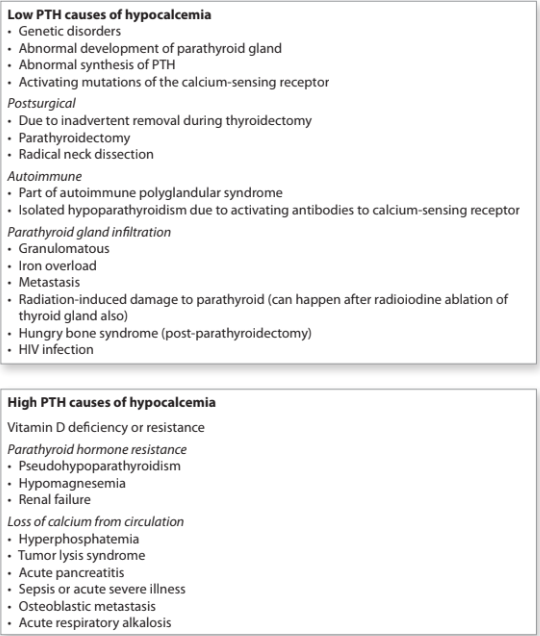An 8-year-old girl is brought with complaints of short stature and recurrent seizures. She was started on antiepileptics about 6 months back but 2 days back she developed tetany and her serum calcium was found to be 5 mg/dL and is hence referred to endocrinology. Her calcium levels at the time of seizures were not checked in the past. She is conscious and oriented at the time of examination. Her pulse rate is 110/min and BP is 90/60 mm Hg and respiratory rate is 20/min; she is afebrile. She has moon facies and alopecia. Her BMI is normal, and secondary sexual characteristics are well-developed. There are no bony deformities in the limbs. Signs of latent tetany (Chvostek and Trousseau signs) are positive. There are bilateral cataracts but no evidence of papilledema. Examination of other systems namely cardiovascular, respiratory, and nervous is normal. Emergency investigations show low total serum calcium of 5 mg/dL (8.5–10.5 mg/dL) and her ionized calcium is 2.5 mg/dL (4.60–5.30 mg/dL). Serum magnesium level (1.5 mg/dL) is low normal and her phosphorus is 8 mg/dL (2.5–4.90 mg/dL) and her parathormone is 500 pg/mL (range 11 to 79.5 pg/mL). A noncontrast (NCCT) scan of the brain reveals bilateral basal ganglia and pineal gland calcification. The QTc interval is prolonged to 0.46 seconds. A provisional diagnosis of hypocalcemic seizures is made.
How to differentiate between the different types of pseudohypopara-thyroidism?
Type 1 a is due to reduction in the Gs-alpha protein. This disorder comprises the biochemical features of hypocalcemia and somatic features of Albright’s hereditary osteodystrophy (AHO) which comprises of short stature, obesity, mental retardation, brachymetacarpia and brachymetatarsia and round facies and subcutaneous bone formation.
Type Ib and Ic have normal Gs-alpha protein but in type Ic the patients have resistance to multiple hormones. Type Ic also has phenotype of Albright’s hereditary osteodystrophy and often present with short stature. Type Ia and Ic have autosomal dominant mode of inheritance. Type Ib is mostly sporadic but familial cases have been reported. Type Ib has a defective kidney response to PTH. In type II, the defect lies downstream after the generation of cyclic AMP as the levels increase normally but it fails to raise the level of serum calcium or urinary phosphate secretion. These patients present with a typical picture suggesting vitamin D deficiency but in vitamin D deficiency the parameters become normal after supplementation with it which does not happen in these cases.

need an explanation for this answer? contact us directly to get an explanation for this answer